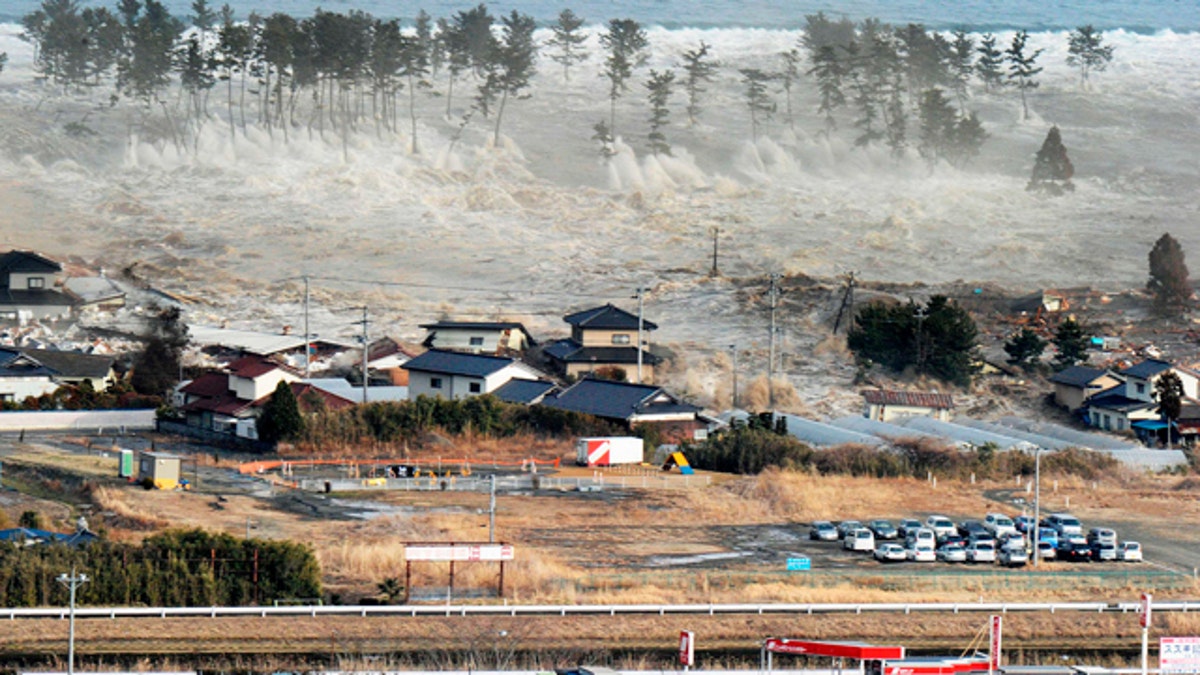
March 11: Waves of tsunami hit residences after a powerful earthquake in Natori, Miyagi prefecture. (AP)
A powerful tsunami spawned by the largest earthquake in Japan's recorded history slammed the eastern coast Friday, sweeping away boats, cars, homes and people as widespread fires burned out of control. Tsunami warnings blanketed the entire Pacific, as far away as South America, Canada, Alaska and the entire U.S. West Coast.
The U.S. Geological Survey (USGS) said the 2:46 p.m. quake was a magnitude 8.9, the biggest earthquake to hit Japan since officials began keeping records in the late 1800s. Geologist Harley Benz told Fox News it was the fifth largest earthquake in the last 100 years.
What caused the gigantic Japanese earthquake, and will it be followed by aftershocks? Here are answers to these and other questions.
What caused the earthquake?
The massive earthquake near the east coast of Honshu, Japan, occurred as a result of faults on or near the subduction zone -- the interface plate boundary between the Pacific and North America plates, the USGS said.
The Pacific plate thrusts underneath Japan at the Japan Trench, and dips to the west beneath Eurasia; these rocky plates cover the planet like a giant jigsaw puzzle and creep past one another at a very slow rate. The Pacific plate moves approximately westwards with respect to the North America plate at a velocity of 3.2 inches per year. The release of energy as the the two plates move past each other is what causes the earthquakes.
The Japan Trench subduction zone is relatively volatile, experiencing 9 earthquakes of magnitude 7 or greater since 1973. The largest of these was a 7.8 magnitude earthquake approximately 162 miles (260 km) to the north of the March 11 event, in December 1994, which caused 3 fatalities and almost 700 injuries, the USGS said. In June of 1978, a 7.7 magnitude earthquake in the area caused 22 fatalities and over 400 injuries.
What does magnitude 8.9 mean?
"It's comparable in size to the earthquake in Chile last year, that was a magnitude 8.8. And very similar kinds of ruptures in both cases," Robert Williams, a geologist with the USGS told Fox News.
Magnitude measures the energy released at the source of the earthquake. Since magnitudes are given on a logarithmic scale, a 7.0-magnitude earthquake would release 10 times as much energy as a 6.0-magnitude temblor. Geoscientists also look at an earthquake's intensity, which measures the strength of shaking produced by the earthquake at a certain location and is determined from the effects that shaking has on people, structures and the environment.
What's the potential for future aftershocks? And foreshocks?
The March 11 earthquake was preceded by a series of large foreshocks over the previous two days.
"There was a 7.2 on March 9, not far from the epicenter of the magnitude 8.9. It looks at this point like that was a foreshock of the 8.9 event," Williams told Fox News. The foreshocks continued with a further three earthquakes greater than 6.0 magnitude on the same day.
A 4.5 magnitude earthquake recently hit Hawaii Friday morning as well, but experts say it is unrelated to the gigantic Japanese quake.
"There's been a series of small earthquakes near the big island of Hawaii where this event happened, and it may be related to the volcanic eruption that's been taking place for several days," Williams said. There have been dozens of large aftershocks since, however, and hundreds of small ones with more to come.
"We've got 35 [aftershocks] now greater than magnitude 5 -- and there's probably hundreds of magnitude 3 and 4." There have been 13 greater than magnitude 6, he said.
"Over the next month, there will be thousands of aftershocks -- many of them felt," he said.
Is there a possibility of an even larger aftershock?
"There's always a slight chance of a larger earthquake," Williams said. "But I'd say it's a very low possibility. What we are seeing so far is that there's a very good chance of magnitude 6 and 7 earthquakes to continue, in an aftershock sequence."
What was the world's deadliest earthquake?
While the death toll in Haiti is still unknown, the deadliest earthquake in history struck that struck Shaanxi, China, in 1556, killing an estimated 830,000 people.
Newswires and LiveScience contributed to this report.
